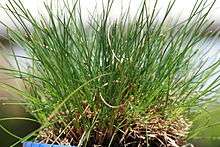Festuca glauca
Festuca glauca, commonly known as blue fescue, is a species of flowering plant in the grass family, Poaceae. It is a commonly cultivated evergreen or semi-evergreen herbaceous perennial.
| Blue fescue | |
|---|---|
 | |
| Scientific classification | |
| Kingdom: | Plantae |
| Clade: | Tracheophytes |
| Clade: | Angiosperms |
| Clade: | Monocots |
| Clade: | Commelinids |
| Order: | Poales |
| Family: | Poaceae |
| Subfamily: | Pooideae |
| Genus: | Festuca |
| Species: | F. glauca |
| Binomial name | |
| Festuca glauca | |
Taxonomy
Common names include blue fescue, blue mountain grass, and grey fescue. Originally described by French naturalist Dominique Villars, its scientific name glauca is derived from the Latin adjective glaucus "pale blue-grey".
Description
F. glauca is a clump-forming ornamental grass noted for its glaucous, finely-textured, blue-gray foliage. The foliage forms a dome-shaped, porcupine-like tuft of erect to arching, needle-like 9-ribbed blades,[1] radiating upward and outward to a length of 140–180 mm. Light green flowers with a purple tinge appear in terminal panicles atop stems rising above the foliage in late spring to early summer, but inflorescences are not very showy. Flowers give way to puffy wheat-like seed-heads.
Cultivation

In cultivation F. glauca can reach a height of 14–18 cm (6–7 in) (inflorescences typically bring total clump height to 20–25 cm (8–10 in)). It does best in well-drained soil as plants will not grow well in wet soils. It tolerates dry and low nutrient soils. Plant in a full sun for best foliage colour. It will also grow in a lightly shaded position. Will tolerate drought, neglect and lack of nutrients but prefers regular watering. If plant has a large amount of dead leaves, prune back to 40mm from ground level. This is to be done in winter. Lift and divide clumps if needed (also to be done in winter). Division of established clumps in winter is the easiest method although, plants can be grown from seed.
Plants require frequent division as clumps tend to die out in the center and need to be divided, replanted or replaced every 2–3 years. Plant foliage may decline considerably in very hot, humid summers. Weeds often build up amongst the clumps when used as groundcover and need to be removed by hand.
Large areas can be removed by hand or sprayed with Glyphosate herbicide.
References
- RHS A-Z encyclopedia of garden plants. United Kingdom: Dorling Kindersley. 2008. p. 1136. ISBN 1405332964.